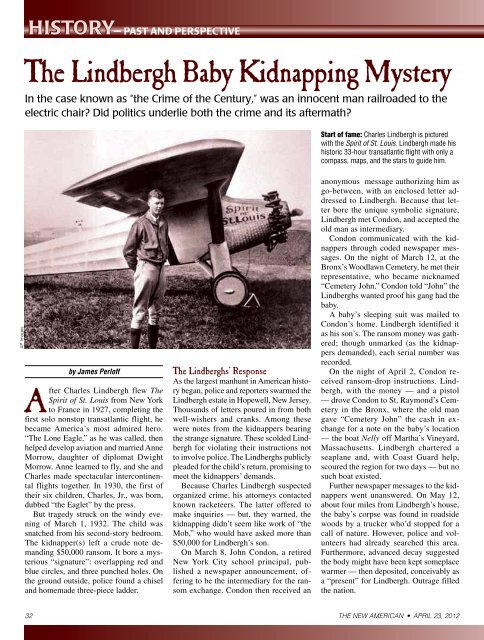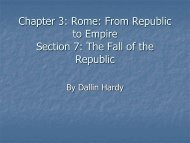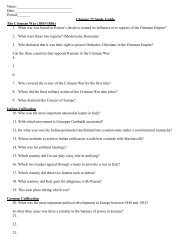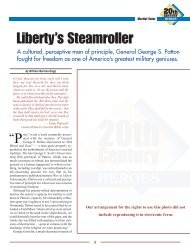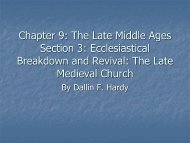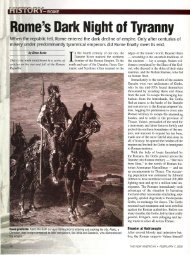The Lindbergh Baby Kidnapping Mystery - Home
The Lindbergh Baby Kidnapping Mystery - Home
The Lindbergh Baby Kidnapping Mystery - Home
Create successful ePaper yourself
Turn your PDF publications into a flip-book with our unique Google optimized e-Paper software.
AP Images<br />
— PAST AND PERSPECTIVE<br />
HISTORY<br />
<strong>The</strong> <strong>Lindbergh</strong> <strong>Baby</strong> <strong>Kidnapping</strong> <strong>Mystery</strong><br />
In the case known as “the Crime of the Century,” was an innocent man railroaded to the<br />
electric chair? Did politics underlie both the crime and its aftermath?<br />
by James Perloff<br />
After Charles <strong>Lindbergh</strong> flew <strong>The</strong><br />
Spirit of St. Louis from New York<br />
to France in 1927, completing the<br />
first solo nonstop transatlantic flight, he<br />
became America’s most admired hero.<br />
“<strong>The</strong> Lone Eagle,” as he was called, then<br />
helped develop aviation and married Anne<br />
Morrow, daughter of diplomat Dwight<br />
Morrow. Anne learned to fly, and she and<br />
Charles made spectacular intercontinental<br />
flights together. In 1930, the first of<br />
their six children, Charles, Jr., was born,<br />
dubbed “the Eaglet” by the press.<br />
But tragedy struck on the windy evening<br />
of March 1, 1932. <strong>The</strong> child was<br />
snatched from his second-story bedroom.<br />
<strong>The</strong> kidnapper(s) left a crude note demanding<br />
$50,000 ransom. It bore a mysterious<br />
“signature”: overlapping red and<br />
blue circles, and three punched holes. On<br />
the ground outside, police found a chisel<br />
and homemade three-piece ladder.<br />
32<br />
<strong>The</strong> <strong>Lindbergh</strong>s’ Response<br />
As the largest manhunt in American history<br />
began, police and reporters swarmed the<br />
<strong>Lindbergh</strong> estate in Hopewell, New Jersey.<br />
Thousands of letters poured in from both<br />
well-wishers and cranks. Among these<br />
were notes from the kidnappers bearing<br />
the strange signature. <strong>The</strong>se scolded <strong>Lindbergh</strong><br />
for violating their instructions not<br />
to involve police. <strong>The</strong> <strong>Lindbergh</strong>s publicly<br />
pleaded for the child’s return, promising to<br />
meet the kidnappers’ demands.<br />
Because Charles <strong>Lindbergh</strong> suspected<br />
organized crime, his attorneys contacted<br />
known racketeers. <strong>The</strong> latter offered to<br />
make inquiries — but, they warned, the<br />
kidnapping didn’t seem like work of “the<br />
Mob,” who would have asked more than<br />
$50,000 for <strong>Lindbergh</strong>’s son.<br />
On March 8, John Condon, a retired<br />
New York City school principal, published<br />
a newspaper announcement, offering<br />
to be the intermediary for the ransom<br />
exchange. Condon then received an<br />
Start of fame: Charles <strong>Lindbergh</strong> is pictured<br />
with the Spirit of St. Louis. <strong>Lindbergh</strong> made his<br />
historic 33-hour transatlantic flight with only a<br />
compass, maps, and the stars to guide him.<br />
anonymous message authorizing him as<br />
go-between, with an enclosed letter addressed<br />
to <strong>Lindbergh</strong>. Because that letter<br />
bore the unique symbolic signature,<br />
<strong>Lindbergh</strong> met Condon, and accepted the<br />
old man as intermediary.<br />
Condon communicated with the kidnappers<br />
through coded newspaper messages.<br />
On the night of March 12, at the<br />
Bronx’s Woodlawn Cemetery, he met their<br />
representative, who became nicknamed<br />
“Cemetery John.” Condon told “John” the<br />
<strong>Lindbergh</strong>s wanted proof his gang had the<br />
baby.<br />
A baby’s sleeping suit was mailed to<br />
Condon’s home. <strong>Lindbergh</strong> identified it<br />
as his son’s. <strong>The</strong> ransom money was gathered;<br />
though unmarked (as the kidnappers<br />
demanded), each serial number was<br />
recorded.<br />
On the night of April 2, Condon received<br />
ransom-drop instructions. <strong>Lindbergh</strong>,<br />
with the money — and a pistol<br />
— drove Condon to St. Raymond’s Cemetery<br />
in the Bronx, where the old man<br />
gave “Cemetery John” the cash in exchange<br />
for a note on the baby’s location<br />
— the boat Nelly off Martha’s Vineyard,<br />
Massachusetts. <strong>Lindbergh</strong> chartered a<br />
seaplane and, with Coast Guard help,<br />
scoured the region for two days — but no<br />
such boat existed.<br />
Further newspaper messages to the kidnappers<br />
went unanswered. On May 12,<br />
about four miles from <strong>Lindbergh</strong>’s house,<br />
the baby’s corpse was found in roadside<br />
woods by a trucker who’d stopped for a<br />
call of nature. However, police and volunteers<br />
had already searched this area.<br />
Furthermore, advanced decay suggested<br />
the body might have been kept someplace<br />
warmer — then deposited, conceivably as<br />
a “present” for <strong>Lindbergh</strong>. Outrage filled<br />
the nation.<br />
THE NEW AMERICAN • ApRIl 23, 2012
<strong>The</strong> Police Response<br />
<strong>The</strong> police suspected an “inside job.” <strong>The</strong><br />
kidnappers knew where the baby’s nursery<br />
was. Furthermore, the <strong>Lindbergh</strong>s always<br />
stayed at the Morrow mansion in Englewood,<br />
New Jersey, on weekdays, while<br />
building their own home in distant rural<br />
Hopewell, where they stayed weekends as<br />
construction finished. On the week of the<br />
kidnapping, however, the baby came down<br />
with a cold, and the <strong>Lindbergh</strong>s decided<br />
to remain longer at Hopewell. Without a<br />
tip, the kidnappers shouldn’t have known<br />
about this variation in routine. <strong>The</strong> baby<br />
was snatched on a Tuesday.<br />
Suspicion fell on Violet Sharp, a Morrow<br />
maid. Sharp had taken Anne <strong>Lindbergh</strong>’s<br />
phone call about the change in<br />
plans. She lied to the police about her<br />
whereabouts the night of the kidnapping,<br />
saying she went to the movies —<br />
but couldn’t recall the film or her date’s<br />
name. On subsequent interrogation, she<br />
said she actually visited a roadhouse with<br />
an Ernie Brinkert — but Brinkert denied it.<br />
After the baby’s corpse was found, Sharp<br />
became increasingly disturbed. When the<br />
police came to question her again, she was<br />
dead, having swallowed cyanide. Oddly,<br />
a different “Ernie” later corroborated her<br />
roadhouse alibi. Today, investigators of<br />
the kidnapping still debate the reason for<br />
Sharp’s suicide — or was it even murder?<br />
Another evidence of “inside help”: Police<br />
found no fingerprints in the nursery<br />
— not even the child’s, his nurse’s, or the<br />
AP Images<br />
<strong>Lindbergh</strong>s’. Eventually, Dr.<br />
Erastus Hudson — pioneer<br />
of a silver nitrate fingerprint<br />
process — lifted latent prints<br />
from the nursery. Hudson<br />
stated the only explanation<br />
for the missing fingerprints<br />
was someone methodically<br />
wiping down the nursery<br />
after the abduction. It hardly seemed likely<br />
the kidnappers waited around to do this.<br />
At the time of the crime, five adults were<br />
in the house — Mr. and Mrs. <strong>Lindbergh</strong>,<br />
the baby’s nurse, the cook, and butler.<br />
Only the butler, Oliver Whateley, was unobserved<br />
during the kidnapping. And like<br />
Violet Sharp, Whateley died suddenly, in<br />
1933 of peritonitis.<br />
Heading the investigation was New Jersey<br />
State Police Superintendent H. Norman<br />
Schwarzkopf — father of “Stormin’<br />
Norman” of Gulf War fame. A “political”<br />
appointee, Schwarzkopf’s only criminal<br />
justice experience before this position was<br />
as a department store floorwalker. President<br />
Herbert Hoover ordered federal agencies<br />
to assist the investigation — a process facilitated<br />
when Congress made kidnapping<br />
a federal crime. J. Edgar Hoover offered<br />
the superior criminology resources of the<br />
Bureau of Investigation (BI — later called<br />
FBI), but Schwarzkopf refused. While some<br />
might commend this as keeping police independent<br />
of federal intrusion, Schwarzkopf<br />
also rejected<br />
<strong>The</strong> ctm: <strong>The</strong> first of the ransom notes for Charles Augustus <strong>Lindbergh</strong>, Jr. bore an occultlooking<br />
“signature.” <strong>The</strong> writing was crude — or designed to look that way.<br />
all U to suscrie toda<br />
After the baby’s corpse was found, Sharp<br />
became increasingly disturbed. When the<br />
police came to question her again, she was<br />
dead, having swallowed cyanide.<br />
local assistance. New Jersey’s Governor authorized<br />
the state’s most famous detective,<br />
Ellis Parker, to help. Known as “America’s<br />
Sherlock Holmes,” Parker had solved over<br />
200 murders. Yet Schwarzkopf declined,<br />
saying Parker was not in his jurisdiction.<br />
Since the kidnapping went unsolved for<br />
over two years, Schwarzkopf’s refusal of<br />
top resources was sharply criticized.<br />
Investigation focused on tracing ransom<br />
bills, which appeared in a trickle. Since<br />
most were passed in New York City —<br />
outside Schwarzkopf’s own jurisdiction<br />
— this entailed interagency cooperation.<br />
Tracing money was difficult, however;<br />
few cashiers delayed customers to check<br />
serial-number lists. Most was found when<br />
later turned in at banks, but efforts to trace<br />
bills to original passers either failed or located<br />
someone cleared of suspicion.<br />
A Suspect at Last<br />
<strong>The</strong> case broke in September 1934. A<br />
Bronx carpenter, Bruno Richard Hauptmann,<br />
passed a $10 ransom bill at a gas<br />
station. Police found about $14,000 more<br />
in ransom money hidden in his home.<br />
<strong>The</strong> German-born Hauptmann told<br />
police he’d discovered the $14,000 in<br />
a box left with him in December 1933<br />
by an associate, Isidor Fisch, who’d<br />
gone to Germany where he died of<br />
tuberculosis. (Fisch had indeed been<br />
in a joint venture with Hauptmann and<br />
died in Germany.) Fisch’s brother was<br />
coming from Germany to settle the estate.<br />
Hauptmann meanwhile decided<br />
to spend some of the cash he’d found<br />
— Fisch owed him over $7,000 anyway,<br />
and Hauptmann said he didn’t know it<br />
was ransom money.<br />
<strong>The</strong> police, however, dismissed Hauptmann’s<br />
explanation as a “Fisch story”; he<br />
was extradited to New Jersey for trial. In<br />
newspapers, the case appeared open-andshut.<br />
Hauptmann had entered the United<br />
States as a stowaway, with a prison record<br />
in Germany for robberies. John Condon<br />
33
— PAST AND PERSPECTIVE<br />
HISTORY<br />
AP Images<br />
<strong>The</strong> Lnberghs’ home in Hopewell, New Jersey, from which the baby was taken. <strong>The</strong> <strong>Lindbergh</strong>s<br />
subsequently donated the house, which today is a home for disadvantaged boys.<br />
identified him as “Cemetery John.” Condon’s<br />
address and phone number were<br />
found scrawled in Hauptmann’s closet.<br />
Two eyewitnesses placed Hauptmann near<br />
the <strong>Lindbergh</strong> residence around the time of<br />
the kidnapping. Handwriting experts indicated<br />
similarities between the ransom notes<br />
and his writing. A federal wood expert said<br />
a board in Hauptmann’s attic matched a rail<br />
in the homemade ladder left at the crime<br />
scene. <strong>The</strong> three-quarter-inch chisel found<br />
at the scene was asserted to be Hauptmann’s<br />
— when police confiscated his<br />
tools, the prosecution said, only the threequarter-inch<br />
chisel was missing.<br />
<strong>The</strong> prosecution claimed Hauptmann<br />
alone did the kidnapping, murder, and ransom<br />
exchange. Brushed aside was the improbability<br />
of a Bronx carpenter knowing<br />
about changes in the <strong>Lindbergh</strong>s’ plans.<br />
<strong>The</strong> jury found Hauptmann guilty; he was<br />
sentenced to death. When Harold Hoffman,<br />
New Jersey’s Republican Governor,<br />
learned much was wrong with the prosecution’s<br />
case, he granted Hauptmann stays of<br />
Another evidence of “inside help”:<br />
Police found no fingerprints in the<br />
nursery — not even the child’s, his<br />
nurse’s, or the <strong>Lindbergh</strong>s’.<br />
34<br />
execution while investigating — to jeers of<br />
newspapers, who accused the Governor of<br />
protecting a child murderer. Asserting innocence<br />
to the end, Hauptmann died in the<br />
electric chair in 1936. <strong>The</strong>n the case was<br />
gradually forgotten — except by Hauptmann’s<br />
widow Anna, who spent nearly 60<br />
years seeking her husband’s vindication.<br />
A breakthrough came with publication<br />
of Scapegoat (1976) by crime reporter Anthony<br />
Scaduto, who examined police and<br />
prosecution records that had been under<br />
wraps for decades.<br />
<strong>The</strong> Players<br />
After World War I, food was scarce in<br />
Germany. Hauptmann, 19 and unable to<br />
find work, did turn to theft with a fellow<br />
ex-soldier. But after prison, he promised<br />
his devout mother, Paulina, it would never<br />
happen again. In 11 years in the United<br />
States before his 1934 arrest, Hauptmann<br />
never committed a known crime. He always<br />
went by his middle name “Richard,”<br />
but newspapers called him “Bruno” — it<br />
sounded more ruthless.<br />
To her regret, Anna Hauptmann<br />
was persuaded by the<br />
Hearst newspaper chain to engage<br />
attorney Edward Reilly.<br />
In exchange for exclusive interviews,<br />
they would pay Reilly’s<br />
fee. With Hauptmann behind<br />
bars and Anna caring for a baby,<br />
the family could not afford the enormous<br />
defense costs — so Anna welcomed the<br />
proposal. Reilly, however, though once<br />
notable, was now an alcoholic and two<br />
years later landed in a mental institution,<br />
suffering effects of syphilis. Before<br />
being hired, he opined that Hauptmann<br />
was guilty and should burn — sentiments<br />
echoed by the Hearst press that paid him.<br />
Reilly spent less than 40 minutes with<br />
Hauptmann before the trial, and though<br />
showing occasional adeptness in court,<br />
made mistakes that cost his client dearly.<br />
After one key blunder, assistant defense<br />
counsel Lloyd Fisher — who never doubted<br />
Hauptmann’s innocence — shouted at<br />
Reilly, “You are conceding Hauptmann to<br />
the electric chair!” Some think Reilly was<br />
hired to deliberately lose; he was seen dining<br />
and boozing with prosecutors.<br />
New Jersey Attorney General David<br />
Wilentz, a powerful Democratic Party<br />
figure, led the prosecution. Responsibility<br />
should have fallen to the county prosecutor,<br />
and Wilentz had never before tried a<br />
criminal case. Some attribute his involvement<br />
to “ambition.” As we will see, there<br />
may have been another reason.<br />
Physical Evidence<br />
• Scaduto discovered the original New<br />
York police receipts for Hauptmann’s<br />
tools, including his three-quarter-inch<br />
chisel; later he found the chisel itself in<br />
storage at New Jersey State Police headquarters<br />
in Trenton. <strong>The</strong> prosecution had<br />
lied about this being missing.<br />
• Hauptmann writing John Condon’s<br />
phone number in his closet made no sense,<br />
since the Hauptmanns had no phone, and<br />
the number was in the phone book anyway.<br />
New York Daily News reporter Tom<br />
Cassidy eventually acknowledged scrawling<br />
it there to get a “scoop.”<br />
• Not one fingerprint linked Hauptmann<br />
to the crime — neither in the nursery nor<br />
on the 13 ransom notes. Fingerprint expert<br />
Dr. Erastus Hudson lifted about 500<br />
prints (including partials) from the homemade<br />
ladder at the scene — but none were<br />
Hauptmann’s. This seemed improbable<br />
if — as prosecutors claimed — he built<br />
it. New Jersey State Police Captain John<br />
Lamb then asked Hudson a stunning question:<br />
Could fingerprints be counterfeited?<br />
Hudson indignantly said yes, but that<br />
counterfeiting was detectable. <strong>The</strong> po-<br />
THE NEW AMERICAN • ApRIl 23, 2012
lice then washed the ladder clean of fingerprints,<br />
and Schwarzkopf refused to let<br />
the public know Hauptmann’s were never<br />
found on it.<br />
• Hauptmann’s shoes were confiscated<br />
for comparison to footprints at the crime<br />
scene and cemetery. <strong>The</strong> prosecution<br />
omitted this evidence — presumably they<br />
didn’t match.<br />
• <strong>The</strong> prosecution’s challenge, then, was<br />
something to physically link Hauptmann<br />
to the kidnapping. <strong>The</strong> New Jersey State<br />
Police took over the lease on the Hauptmanns’<br />
apartment. Detective Lewis Bornmann<br />
— whose superior was Lamb — actually<br />
lived there. He suddenly reported<br />
discovering a partially missing floorboard<br />
in Hauptmann’s attic — even though this<br />
was unnoticed in nine documented previous<br />
searches of the attic by 37 law-enforcement<br />
agents. At the trial, the prosecution<br />
claimed a kidnap-ladder rail matched the<br />
remaining partial-board in Hauptmann’s<br />
attic, though of different width and depth.<br />
Why would Hauptmann — a professional<br />
carpenter with abundant lumber in his garage<br />
— rip a board from his attic to help<br />
build a ladder? Nonetheless, this became<br />
the prosecution’s “smoking gun.”<br />
Changing Testimonies<br />
• Hauptmann said he worked at the Majestic<br />
Apartments in New York City until<br />
AP Images<br />
5 p.m. the day of the kidnapping. His<br />
supervisor Joseph Furcht confirmed this<br />
in a sworn affidavit with attached documentation.<br />
But after being summoned to<br />
the New York District Attorney’s office,<br />
Furcht was no longer “positive,” and work<br />
records for that time vanished.<br />
• Both of the witnesses placing Hauptmann<br />
near the crime scene were discreditable<br />
and handsomely paid. Unknown to<br />
the defense, 87-year-old Amandus Hochmuth<br />
was partially blind and admitted to<br />
prosecutors pretrial that he couldn’t identify<br />
Hauptmann. When Governor Hoffman<br />
interviewed Hochmuth, he couldn’t identify<br />
a flower vase 10 feet away. Illiterate<br />
Millard Whithed, labeled a chronic liar<br />
by neighbors, had denied to police seeing<br />
anything suspicious after the kidnapping<br />
— but came forward two years later, motivated<br />
by reward money.<br />
Hauptmann had much better witnesses<br />
for the kidnapping time-frame. On<br />
Tuesdays his wife Anna worked late at<br />
Fredericksen’s, a New York bakery-café.<br />
Hauptmann always waited there for Anna,<br />
and sometimes walked the Fredericksens’<br />
dog. Not only did the Fredericksens confirm<br />
Hauptmann was there on the kidnapping<br />
evening, but August Von Henke saw<br />
Hauptmann walking the dog. Mistaking<br />
it for his own lost dog, he argued with<br />
Hauptmann. Louis Kiss, a bakery custom-<br />
er, remembered the argument. Von Henke<br />
and Kiss weren’t friends of Hauptmann,<br />
had no incentive to lie, and threatened the<br />
prosecution’s case.<br />
<strong>The</strong> day after Kiss testified, a New<br />
York attorney named Berko pressed him<br />
to change his testimony with a threat of arrest<br />
and an offer of money. Berko admitted<br />
his legal career was failing, but that Attorney<br />
General Wilentz offered to help him<br />
get a position on Manhattan special prosecutor<br />
Thomas Dewey’s staff if he could<br />
persuade Kiss to recant his testimony. Kiss<br />
informed Berko he’d told the truth in court<br />
and wouldn’t change it for any price. He<br />
summarized the incident in a sworn deposition<br />
corroborated by a witness.<br />
• When Hauptmann was arrested, Condon<br />
declined to say he was “Cemetery<br />
John.” FBI agent Leon Turrou wrote: “He<br />
[Condon] remarked on one occasion that<br />
Hauptmann is not the man because he appears<br />
to be much heavier, different eyes,<br />
different hair, etc.” Yet in court, after reportedly<br />
being threatened with “obstructing<br />
justice,” Condon emphatically identified<br />
Hauptmann as “Cemetery John.”<br />
• After Hauptmann’s arrest, the New<br />
York police gave samples of his writing to<br />
handwriting expert Albert D. Osborn, who<br />
reported they didn’t match the ransom<br />
notes. But after the frustrated police told<br />
Osborn large ransom sums were in Hauptmann’s<br />
residence, Osborn requested more<br />
samples. <strong>The</strong> police forced Hauptmann<br />
to write the ransom note words dozens<br />
of times; “best” examples were selected.<br />
Osborn changed his mind, explaining in<br />
court that Hauptmann made the same<br />
spelling errors as the actual ransom notes.<br />
But as Scaduto revealed, the police forced<br />
Hauptmann to write with the spelling mistakes<br />
dictated to him.<br />
<strong>The</strong> state paid eight handwriting experts<br />
over $33,000 to testify that Hauptmann<br />
wrote the notes. But “experts”<br />
testify for who pays their fee, and many<br />
differences in Hauptmann’s writing were<br />
disregarded. <strong>The</strong> defense could only afford<br />
one handwriting expert, who was<br />
simply outnumbered.<br />
<strong>The</strong> homemae three-secton nap<br />
laer, which remains controversial to this<br />
day, is brought to court by a state trooper. Its<br />
light weight suggested it was designed for<br />
rapid carry.<br />
.heemerican.com 35
— PAST AND PERSPECTIVE<br />
HISTORY<br />
• Isidor Fisch, who Hauptmann said left<br />
the “money box,” had been a confidence<br />
man in many swindles, even swindling<br />
Hauptmann in their joint venture. Fisch<br />
was seen laundering “hot money” after the<br />
ransom payment, and applied for a passport<br />
the day the baby’s body was found.<br />
Hauptmann’s friend Hans Kloppenburg<br />
saw Fisch give him the box before departing<br />
for Germany. Kloppenburg told<br />
Anthony Scaduto that prosecutor Wilentz<br />
warned him: “If you say on the witness<br />
chair that you seen Fisch come in with the<br />
shoe box, you’ll be arrested right away.”<br />
Kloppenburg testified anyway.<br />
• Wilentz used a partner of Isidor Fisch<br />
— ex-con Charlie Schleser — to spy on<br />
defense witnesses. Feigning friendliness<br />
to Hauptmann, Schleser learned about defense<br />
plans and reported to Wilentz.<br />
Climax<br />
In his summation to the jury, Wilentz demanded<br />
the death penalty, calling Hauptmann<br />
“a fellow that had ice water in his<br />
veins, not blood … an animal lower than<br />
the lowest form in the animal kingdom,<br />
Public Enemy Number One of this world<br />
… no heart, no soul.”<br />
Wilentz’s summation violated jurisprudence<br />
rules by introducing new arguments;<br />
he described Hauptmann using the<br />
chisel to bludgeon the child in the nursery.<br />
Had he suggested this during normal proceedings,<br />
the defense could have refuted<br />
it — the nursery had no signs of bloody<br />
violence.<br />
However, the judge, Thomas Trenchard,<br />
gave Wilentz leeway — as he had throughout<br />
the trial. <strong>The</strong> court transcript reveals<br />
Trenchard’s marked bias toward the prosecution,<br />
overruling the defense in great disproportion.<br />
Perhaps the worst impropriety<br />
was his 70-minute charge to the jury, in<br />
which he aggressively argued for the prosecution.<br />
Reviewing the defense’s arguments<br />
point by point, Trenchard repeated,<br />
“Do you believe that?” By emphasizing<br />
the word “that,” Trenchard conveyed disdain<br />
— but helped protect himself, since<br />
court records didn’t include voice inflections.<br />
While the jury deliberated, a mob surrounded<br />
the courthouse chanting, “Kill<br />
Hauptmann!” Perhaps some jurors feared<br />
becoming victims of mob violence unless<br />
their verdict was “guilty of murder in the<br />
36<br />
Whose nterests he represent? Bruno Richard Hauptmann (right) with his attorney Edward<br />
J. Reilly. After the Hearst press paid his fee up front, Reilly showed limited interest in his client.<br />
first degree” — which it was. As Editor<br />
and Publisher declared, “No trial in this<br />
century has so degraded the administration<br />
of justice.”<br />
Hauptmann was told if he would confess,<br />
his death sentence would be commuted to<br />
life imprisonment. He refused. His spiritual<br />
advisor, Reverend John Matthiesen, stated:<br />
“I have had fifteen very intimate and soul<br />
searching interviews with Bruno Richard<br />
Hauptmann, and am convinced that he tells<br />
the truth.” Just before electrocution, Hauptmann<br />
requested that John 14 be read to him,<br />
then kneeled in prayer. His final statement<br />
(translated from German):<br />
Soon I will be at home with my<br />
Lord, so I am dying an innocent man.<br />
Should, however, my death serve for<br />
the purpose of abolishing capital<br />
punishment — such a punishment<br />
being arrived at only by circumstantial<br />
evidence — I feel that my death<br />
has not been in vain. I am at peace<br />
with God. I repeat, I protest my innocence<br />
of the crime for which I<br />
was convicted. However, I die with<br />
no malice or hatred in my heart. <strong>The</strong><br />
love of Christ has filled my soul and<br />
I am happy in Him.<br />
In a generation no longer gripped with<br />
media-driven hatred of Hauptmann, Anthony<br />
Scaduto (and subsequent writers<br />
like Ludovic Kennedy) convinced many<br />
that the carpenter was railroaded to the<br />
electric chair. But if Hauptmann didn’t do<br />
it, who did?<br />
Attacking <strong>Lindbergh</strong><br />
Over the last two decades, some authors<br />
have claimed Charles <strong>Lindbergh</strong>, or others<br />
in his family, killed the baby. This began<br />
with Crime of the Century: <strong>The</strong> <strong>Lindbergh</strong><br />
<strong>Kidnapping</strong> Hoax (1993) by Gregory Ahlgren<br />
and Stephen Monier, whose contempt<br />
for the aviator is undisguised.<br />
<strong>Lindbergh</strong>, known as a practical joker,<br />
once hid the baby from Anne as a prank.<br />
From that, the authors devised this scenario:<br />
Returning home from work on March<br />
1, 1932, Charles decided to play a joke.<br />
He himself climbed the ladder and took the<br />
baby, intending to enter the front door saying,<br />
“Look who was with me in New York.”<br />
But, they declare, he accidentally dropped<br />
the baby, killing him. <strong>Lindbergh</strong>, concerned<br />
only for his reputation, drove off, dumped<br />
the body in the woods four miles away, hurried<br />
home and wrote a fake ransom note before<br />
the baby’s nurse returned to the nursery.<br />
THE NEW AMERICAN • ApRIl 23, 2012<br />
AP Images
<strong>The</strong>ir source for this? <strong>The</strong>ir imagination.<br />
<strong>The</strong>ir 286-page volume has only one<br />
page of footnotes. This theory, like many,<br />
cherry-picks details that support it while<br />
ignoring what doesn’t. <strong>The</strong> ladder abandoned<br />
at the scene didn’t belong to <strong>Lindbergh</strong><br />
and wasn’t sturdy — if he’d wanted<br />
a ladder, he had a strong one in his garage.<br />
It was dark with a gale blowing; with no<br />
one holding the ladder steady, it would<br />
have been insanity for <strong>Lindbergh</strong> to risk<br />
his life and his sick child’s for a joke.<br />
<strong>Lindbergh</strong>’s daughter Reeve says he<br />
was “very gentle” as a father, and he was<br />
unquestionably courageous. If <strong>Lindbergh</strong><br />
had really dropped his son, his instinct<br />
would have been to seek help — not cravenly<br />
dump the body in the woods.<br />
Many people offered to pay the ransom.<br />
But <strong>Lindbergh</strong> insisted on paying himself,<br />
selling investments at steep losses to raise<br />
the $50,000 (around a million dollars in<br />
today’s currency). If Ahlgren and Monier<br />
are correct, why would <strong>Lindbergh</strong> pay the<br />
ransom knowing the child was dead?<br />
Others go beyond this “prank” hypothesis.<br />
<strong>Lindbergh</strong> was a leader of the America<br />
First Committee, which,<br />
before Pearl Harbor, tried to<br />
keep the United States out of<br />
World War II. Some <strong>Lindbergh</strong><br />
haters claim he was<br />
a “Nazi racial supremacist,”<br />
and deliberately murdered<br />
his son over some defect in<br />
health or appearance. In fact,<br />
Charles, Jr. was a handsome,<br />
healthy boy who could talk<br />
and run. Although less than<br />
two, he already attended a<br />
Montessori-type preschool.<br />
He did have rickets (not uncommon<br />
then) and a couple<br />
overlapping toes — hardly<br />
incentives for murder.<br />
One year after the Ahlgren-Monier<br />
book came<br />
Noel Behn’s <strong>Lindbergh</strong>:<br />
<strong>The</strong> Crime, alleging Anne’s<br />
sister Elisabeth had wanted<br />
to marry Charles and killed<br />
the baby out of jealousy,<br />
and Charles covered that<br />
up. Behn based this largely<br />
on undocumented recollections<br />
of 93-year-old Harry<br />
Green — an investigator<br />
once attached to the case — even<br />
though he admits “Green had a<br />
habit pleading senility.”<br />
William Norris, in A Talent to<br />
Deceive, claimed <strong>Lindbergh</strong>’s<br />
brother-in-law, Dwight Morrow,<br />
Jr., murdered the baby.<br />
<strong>The</strong>se suspects, rotated like a<br />
game of Clue, are all <strong>Lindbergh</strong><br />
family members. <strong>The</strong> theorists<br />
rely largely on the same<br />
“proofs.” Five trendy ones:<br />
1. “Why did <strong>Lindbergh</strong> call<br />
his LAWYER before calling the police?”<br />
So asks the website lindberghkidnappinghoax.com,<br />
implying legalities worried<br />
<strong>Lindbergh</strong> more than his child. This<br />
question twists the truth over a technicality.<br />
While <strong>Lindbergh</strong> searched the grounds<br />
with a gun, he had the butler phone the<br />
police. Later he called his friend/attorney<br />
Henry Breckinridge for advice.<br />
2. Why didn’t <strong>Lindbergh</strong> immediately<br />
open the ransom note? A concerned parent<br />
would! <strong>Lindbergh</strong> knew a crime scene<br />
shouldn’t be disturbed, and that police<br />
would dust the note for fingerprints —<br />
dr. Erastus Huson testified for<br />
the defense. Not one fingerprint<br />
linked Hauptmann to the<br />
nursery, ladder, or ransom<br />
notes.<br />
Both of the witnesses placing<br />
Hauptmann near the crime scene were<br />
discreditable and handsomely paid.<br />
Unknown to the defense, 87-year-old<br />
Amandus Hochmuth was partially blind<br />
and admitted to prosecutors pretrial that<br />
he couldn’t identify Hauptmann.<br />
which they did. If <strong>Lindbergh</strong> had torn that<br />
note open, his critics would surely excoriate<br />
his “obstructing justice.”<br />
3. <strong>Lindbergh</strong> kept the police from the<br />
ransom drop — he was hiding something!<br />
<strong>The</strong> kidnappers had warned <strong>Lindbergh</strong> not<br />
to involve police. <strong>The</strong> <strong>Lindbergh</strong>s complied;<br />
their priority was the child’s life.<br />
Many kidnapping victims have paid ransoms<br />
without even notifying authorities.<br />
Note the two-headed coin of <strong>Lindbergh</strong>’s<br />
critics — cooperating with police means<br />
“guilt”; so does not cooperating.<br />
4. <strong>Lindbergh</strong> himself wiped off the fingerprints<br />
in the nursery! <strong>The</strong><br />
fingerprints of <strong>Lindbergh</strong><br />
and his family would be expected<br />
in the nursery. <strong>The</strong><br />
wipedown could have only<br />
benefited outsiders.<br />
5. <strong>Lindbergh</strong> cremated the<br />
baby’s remains to destroy evidence!<br />
<strong>Lindbergh</strong>, the child’s<br />
nurse, and the child’s pediatrician<br />
viewed the remains.<br />
An autopsy was performed.<br />
However, a news reporter and<br />
photographer gained entry to<br />
the mortuary, forced open the<br />
casket, and photographed the<br />
remains. Realizing their baby<br />
would never escape paparazzi<br />
exploitation, the <strong>Lindbergh</strong>s<br />
respectfully decided to cremate,<br />
and scattered the ashes<br />
from an airplane.<br />
Let the arbiter be Anna<br />
Hauptmann, who fought<br />
for six decades to exonerate<br />
her husband. Though<br />
Ahlgren and Monier took<br />
blame off him in promoting<br />
their claim, Anna said<br />
she was “outraged” another<br />
AP Images<br />
37
HISTORY HISTORY—<br />
PAST AND PERSPECTIVE<br />
<strong>The</strong> state paid eight handwriting experts<br />
over $33,000 to testify that Hauptmann<br />
wrote the notes. But “experts” testify for<br />
who pays their fee, and many differences in<br />
Hauptmann’s writing were disregarded.<br />
book was exploiting the tragedy. Her attorney,<br />
Robert Bryan, called their book<br />
“reckless” and “full of errors.”<br />
Why <strong>Lindbergh</strong>?<br />
In 1992’s Republican presidential primaries,<br />
Pat Buchanan was the leading opponent<br />
to George Bush, Sr. Buchanan deliberately<br />
revived <strong>Lindbergh</strong>’s cry “America<br />
First” while challenging the interventionism<br />
of neocons in Bush’s administration.<br />
This battle continued in 1993-94 (when<br />
the Ahlgren-Monier and Behn books appeared),<br />
as patriots fought to keep America<br />
out of NAFTA and the World Trade<br />
Organization. Joining those entanglements<br />
devastated American manufacturing and<br />
sent millions of jobs overseas.<br />
No one had symbolized “isolationism”<br />
more than <strong>Lindbergh</strong>. And his father,<br />
U.S. Congressman Charles <strong>Lindbergh</strong>,<br />
Sr., was a chief opponent of our entering<br />
World War I and bitterly fought the Federal<br />
Reserve Act, which he prophesied<br />
would benefit a few bankers while plaguing<br />
average Americans with inflation and<br />
economic despair.<br />
In the 1990s, globalists of the Council<br />
on Foreign Relations (CFR) — whose<br />
members dominate key positions in both<br />
Republican and Democratic administrations<br />
— envisioned a “new world order”<br />
where America would yield sovereignty<br />
to a NAFTA-based North American<br />
Union and engage in endless foreign<br />
interventions. <strong>The</strong>y also thirsted for billions<br />
in bailout dollars for their multinational<br />
banks and corporations. Since these<br />
bailouts would come largely from “fiat”<br />
money (created from nothing by the U.S.<br />
Federal Reserve), working Americans<br />
would pay for the bailouts through soaring<br />
inflation.<br />
<strong>The</strong>se schemes required manipulation<br />
of public opinion. <strong>The</strong> name “<strong>Lindbergh</strong>”<br />
symbolized opposition to them.<br />
38<br />
And since the aviator was<br />
still emblazoned as a hero,<br />
now was the time to destroy<br />
his image. New books would<br />
repaint “the Lone Eagle” as<br />
“the Nazi who murdered his<br />
own son.”<br />
In 2002, President Bush<br />
appointed Stephen Monier<br />
U.S. Marshal for New<br />
Hampshire.<br />
A New <strong>The</strong>ory<br />
According to the FBI’s files on the kidnapping<br />
(released in 1999), gangster Johnny<br />
Torrio, Al Capone’s mentor, “expressed<br />
his opinion to the Intelligence Unit agents<br />
that the <strong>Lindbergh</strong> baby was not kidnapped<br />
for ransom … that the baby was<br />
kidnapped and subsequently murdered by<br />
someone who had a grouch against <strong>Lindbergh</strong><br />
and it was purely a case of personal<br />
vengeance.”<br />
Logic dictates the kidnapping wasn’t<br />
about $50,000. That was a lot in 1932 —<br />
but there were many wealthier families<br />
whom the public never heard of. To take<br />
Corbis<br />
Lindy’s kid for money would be foolish<br />
— the whole country would be after you.<br />
Besides inside knowledge of the <strong>Lindbergh</strong>s’<br />
plans, much evidence suggested<br />
conspiracy. Several police officers attempted<br />
to reenact the abduction singlehandedly,<br />
yet none succeeded — even<br />
with a sturdier ladder in daylight. <strong>Lindbergh</strong><br />
and Condon believed they saw lookouts<br />
at the cemeteries. Ransom money still<br />
appeared after Hauptmann’s arrest. Ellis<br />
Parker — considered New Jersey’s best<br />
detective — independently found another<br />
suspect. But ironically it was Parker who<br />
went to prison; in seizing the suspect, it<br />
was charged he’d violated the new federal<br />
kidnapping law!<br />
<strong>The</strong> prosecution suppressed all evidence<br />
of conspiracy, claiming Hauptmann<br />
acted alone. Wilentz’ insistence on the<br />
death penalty, not life imprisonment, made<br />
little sense, given the meager evidence. If<br />
really guilty, in prison Hauptmann might<br />
eventually reveal how the crime was done,<br />
or name accomplices. Electrocution made<br />
this impossible. Was Hauptmann made a<br />
patsy to protect someone?<br />
Charles, age eght, wth hs Congressman father:<br />
To define their stand on foreign policy, both<br />
<strong>Lindbergh</strong>s used the phrase “America First”—<br />
which former CFR member Chester Ward said is<br />
the most despised phrase in the CFR.
AP Images<br />
<strong>The</strong> trial’s injustices — involving the<br />
prosecution, judge, and some police officers<br />
— suggest a powerful hand at work.<br />
<strong>Lindbergh</strong> was popular, but lacked the<br />
wealth and political influence to compromise<br />
an entire justice system. Could<br />
the kidnapping, and eventual smearing of<br />
<strong>Lindbergh</strong> as perpetrator, both trace to the<br />
<strong>Lindbergh</strong>s’ enemies?<br />
In his new book <strong>The</strong> <strong>Lindbergh</strong> <strong>Baby</strong><br />
Kidnap Conspiracy, Professor Alan Marlis,<br />
who taught for 35 years at City University<br />
of New York, believes James P.<br />
Warburg was behind the kidnapping. A<br />
prominent banker and member of President<br />
Franklin D. Roosevelt’s “brain trust,”<br />
Warburg is perhaps best remembered for<br />
telling a Senate subcommittee in 1950 we<br />
would have world government “by conquest<br />
or consent.” He was the son of Federal<br />
Reserve architect Paul Warburg.<br />
Marlis’ book, currently available only<br />
from the McNally Jackson Bookstore in<br />
New York City, is clearly a self-published<br />
manuscript, but demonstrates extensive<br />
research. Marlis describes a context of<br />
sudden deaths for enemies of the FDR-<br />
Federal Reserve crowd:<br />
• Walter Liggett, speechwriter for <strong>Lindbergh</strong>,<br />
Sr., was murdered in 1935 — a case<br />
never solved.<br />
• In 1936, Louisiana politician Huey<br />
Long, possibly FDR’s biggest reelection<br />
threat, was assassinated — an incident still<br />
controversial.<br />
• Louis McFadden, the Fed’s chief con-<br />
.heemerican.com<br />
gressional critic, survived two attempts on<br />
his life before dying suddenly, also in 1936.<br />
• After triggering the Great Depression,<br />
“establishment” bankers wanted Roosevelt<br />
elected as President in 1932 to spawn an<br />
era of government borrowing, erosion of<br />
the Constitution, and moves toward world<br />
government. <strong>Lindbergh</strong>’s father-in-law,<br />
Dwight Morrow, now Republican Senator<br />
for New Jersey, was touted as a possible<br />
presidential candidate. In October 1931,<br />
Morrow, 58 and fit, attended a charity dinner<br />
hosted by Lehman Brothers — heavy<br />
backers of FDR. (Herbert Lehman was<br />
Roosevelt’s Lieutenant Governor in New<br />
York and signed the papers extraditing<br />
Hauptmann to New Jersey.) After the dinner,<br />
Morrow returned home — and died<br />
that night. Thus vanished a remaining<br />
hope for the Republicans, whom newspapers<br />
blamed for the Depression.<br />
In 1932, one man still posed a threat<br />
to FDR’s election — Charles <strong>Lindbergh</strong>.<br />
Lindy was too young constitutionally to<br />
run for President, but his popularity was<br />
so universal that his active presence alone<br />
might have kept Republican hopes alive.<br />
But five months after Morrow’s sudden<br />
death, <strong>Lindbergh</strong>’s baby was murdered —<br />
effectively removing the grieving father<br />
from the political scene. Some of the links<br />
Marlis draws to James Warburg:<br />
• <strong>The</strong> <strong>Lindbergh</strong>s and Warburgs had<br />
what Marlis calls a “blood feud.” In 1913,<br />
Charles <strong>Lindbergh</strong>, Sr. tried to stop creation<br />
of the Federal Reserve — which Paul<br />
A new boo blames hm: James P. Warburg sits<br />
before the Senate Banking Committee in April<br />
1935, about two months after Hauptmann was<br />
sentenced. <strong>The</strong> friction between Warburg and<br />
Charles <strong>Lindbergh</strong> echoed that of their fathers.<br />
Warburg, its first vice-chairman, had designed.<br />
In 1917, <strong>Lindbergh</strong> tried to have<br />
Warburg, as well as FDR’s uncle Frederic<br />
Delano, impeached from the Federal Reserve<br />
Board. According to Marlis, <strong>Lindbergh</strong><br />
“Jew-baited” Warburg at the Fed<br />
chairman hearings; Paul told his son, and<br />
the insult wasn’t forgotten.<br />
• In 1941, the fathers’ feud continued<br />
between the sons. James Warburg helped<br />
found and finance the Freedom First Committee<br />
to oppose <strong>Lindbergh</strong>’s America<br />
First Committee, debated <strong>Lindbergh</strong> at<br />
Madison Square Garden, and publicly denounced<br />
him.<br />
• Paul Warburg died less than two<br />
months before the kidnapping.<br />
• <strong>The</strong> police had suspected the crime<br />
was an inside job. <strong>The</strong> governess in James<br />
Warburg’s household was the sister of the<br />
Morrows’ seamstress, Marguerite Junge,<br />
who knew about the <strong>Lindbergh</strong>s’ change<br />
of plans. Junge’s alibi for the kidnapping<br />
night: She was “out riding” with Red<br />
Johnsen — boyfriend of the baby’s nurse.<br />
• In April 1932 (just after the kidnapping<br />
and ransom payment), James Warburg<br />
took a two-month trip to Europe.<br />
• Warburg’s estate was in Greenwich,<br />
Connecticut — the town where the very<br />
first <strong>Lindbergh</strong> ransom gold certificate<br />
was passed, by a well-dressed woman at<br />
a bakery. <strong>The</strong> cashier, checking the serialnumber<br />
list, exclaimed it was <strong>Lindbergh</strong><br />
ransom money. <strong>The</strong> woman snatched it<br />
back and ran outside into a chauffeured<br />
sedan — which police unsuccessfully<br />
searched for.<br />
Dr. Marlis makes an interesting case,<br />
but also seems to draw some unnecessary<br />
inferences from coincidences. Warburg ordering<br />
the kidnapping cannot be proven.<br />
As with Hauptmann, fairness should negate<br />
“convicting” him on circumstantial<br />
evidence.<br />
This article could not address many<br />
facets of this still-debated case. For those<br />
interested in more, good starts are Anthony<br />
Scaduto’s Scapegoat, Lloyd Gardner’s<br />
balanced <strong>The</strong> Case That Never Dies, and<br />
www.lindberghkidnap.proboards.com. n<br />
39


